
Today marks the start of retail availability for Intel's 2021 gaming CPU lineup, codenamed Rocket Lake-S. Rocket Lake-S is still stuck on Intel's venerable 14 nm process—we've long since lost count of how many pluses to tack onto the end—with features backported from newer 10 nm designs.
Clock speed on Rocket Lake-S remains high, but thread counts have decreased on the high end. Overall, most benchmarks show Rocket Lake-S underperforming last year's Comet Lake—let alone its real competition, coming from AMD Ryzen CPUs.
Our hands-on test results did not seem to match up with Intel's marketing claims of up to 19 percent gen-on-gen IPC (Instructions Per Clock cycle) improvement over its 10th-generation parts.
Multithreaded CPU performance
 Core i9-11900K has two fewer cores than last year's i9-10900K, resulting in poorer multithreaded performance.Jim Salter
Core i9-11900K has two fewer cores than last year's i9-10900K, resulting in poorer multithreaded performance.Jim Salter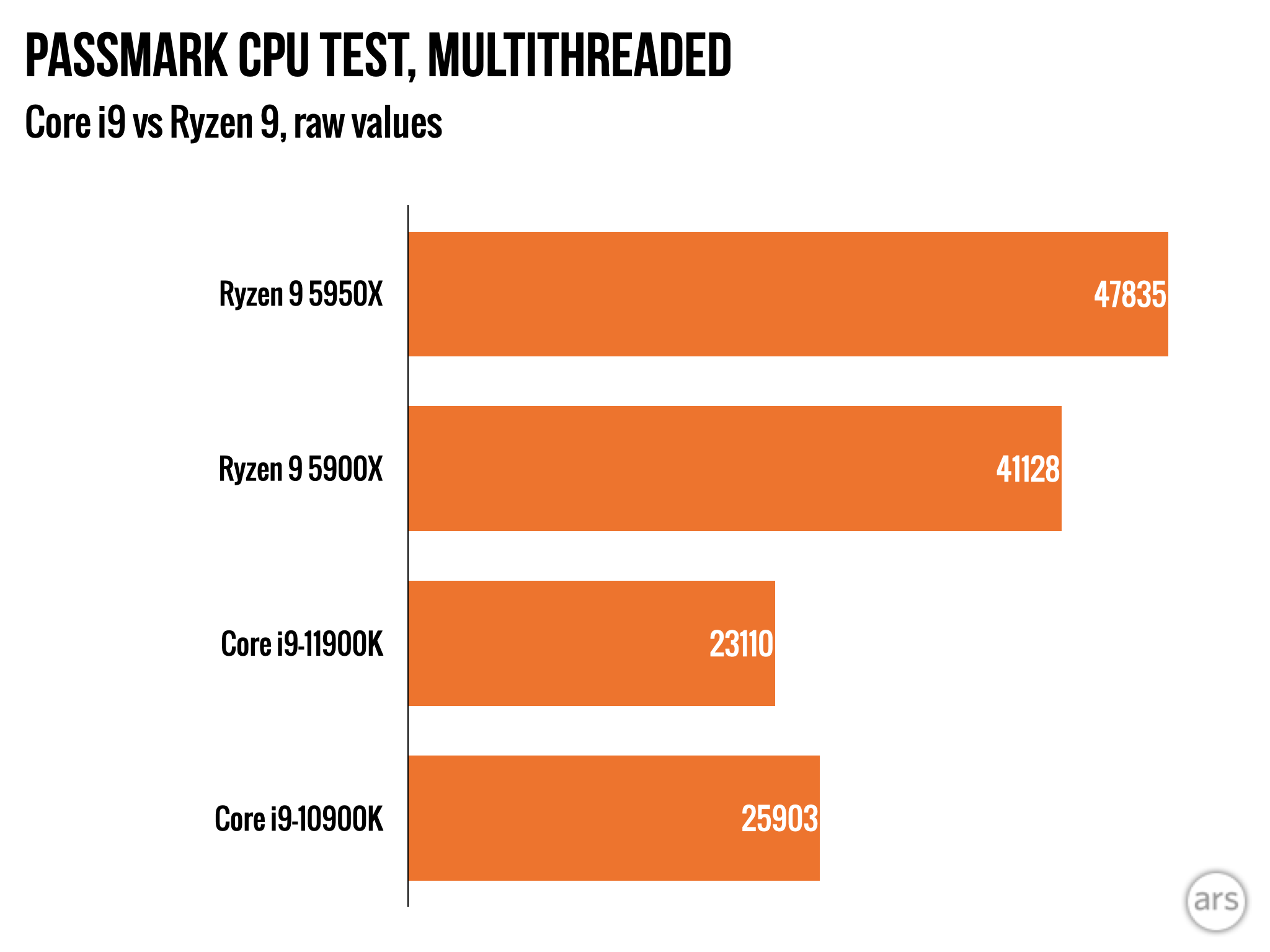 In multithreaded Passmark, the i9-11900K falls behind last year's i9—let alone the Ryzen 9 series.Jim Salter
In multithreaded Passmark, the i9-11900K falls behind last year's i9—let alone the Ryzen 9 series.Jim Salter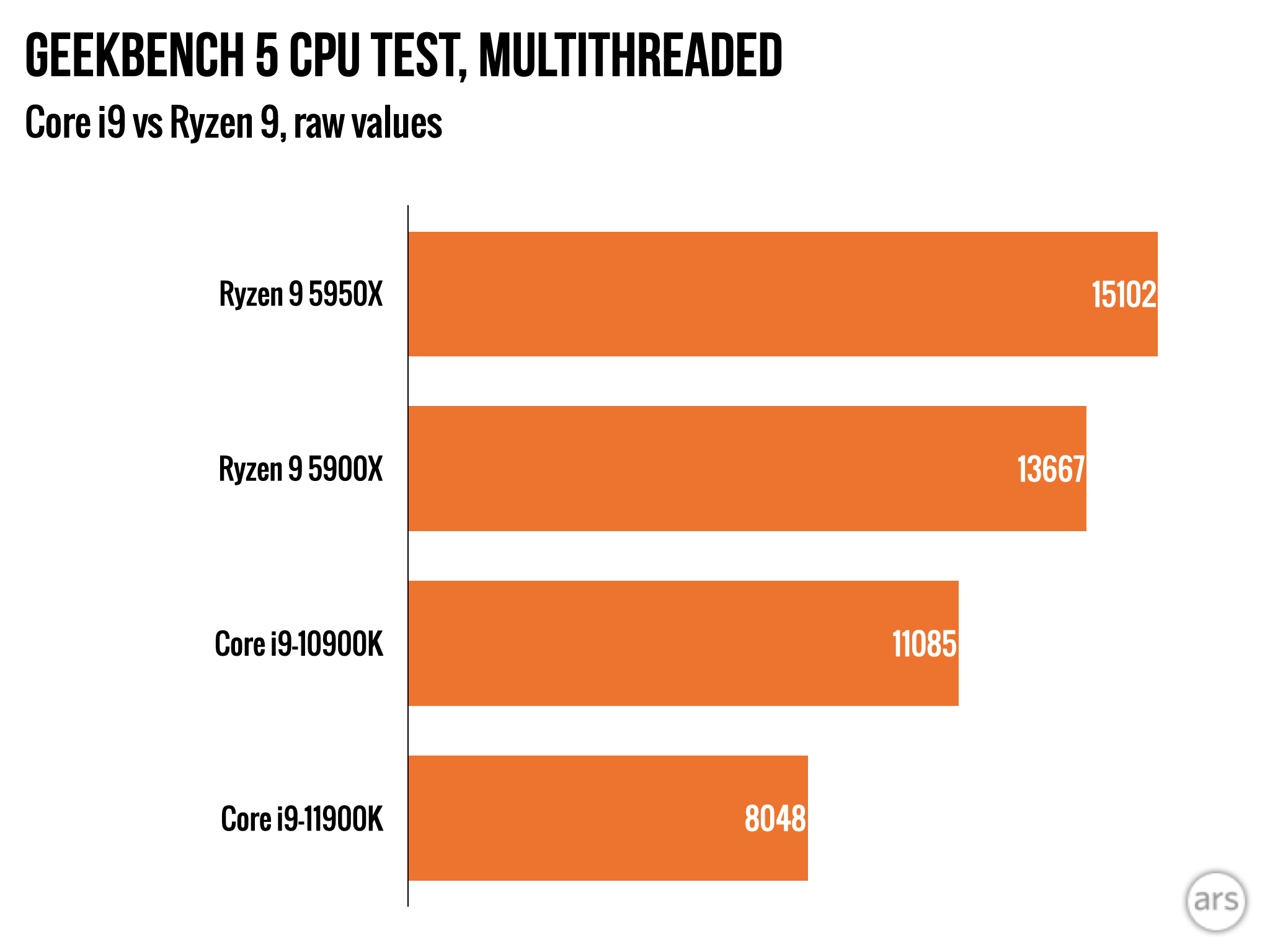 Even Geekbench 5—which tends to flatten multithreaded advantages severely—shows this year's Core i9 underperforming last year's.Jim Salter
Even Geekbench 5—which tends to flatten multithreaded advantages severely—shows this year's Core i9 underperforming last year's.Jim Salter
It shouldn't come as an enormous surprise that Core i9-11900K underperforms last year's Core i9-10900K in multithreaded tests—this year's model only offers eight cores to last year's 10. If this part had shown a 19 percent improvement in IPC, that might have come out to a wash—20 percent fewer cores, balanced out with 19 percent higher IPC.
What we actually saw was noticeably decreased performance across the board. Cinebench R20 and Passmark scores are each down about 10 percent. Geekbench 5, which tends to minimize the impact of higher thread counts, shows an alarming 27 percent gen-on-gen performance decrease.
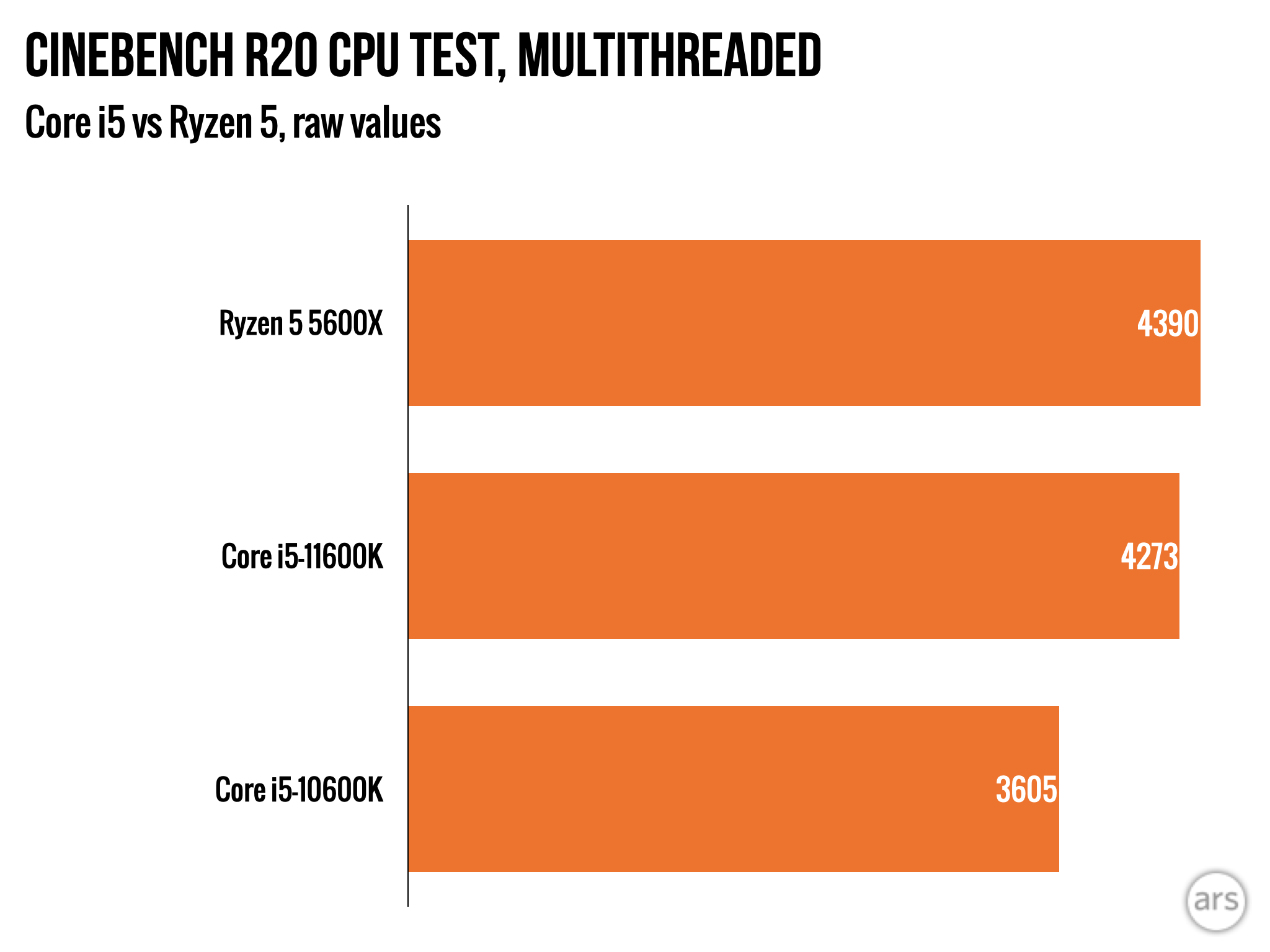 i5-11600K improves significantly over last year's equivalent.Jim Salter
i5-11600K improves significantly over last year's equivalent.Jim Salter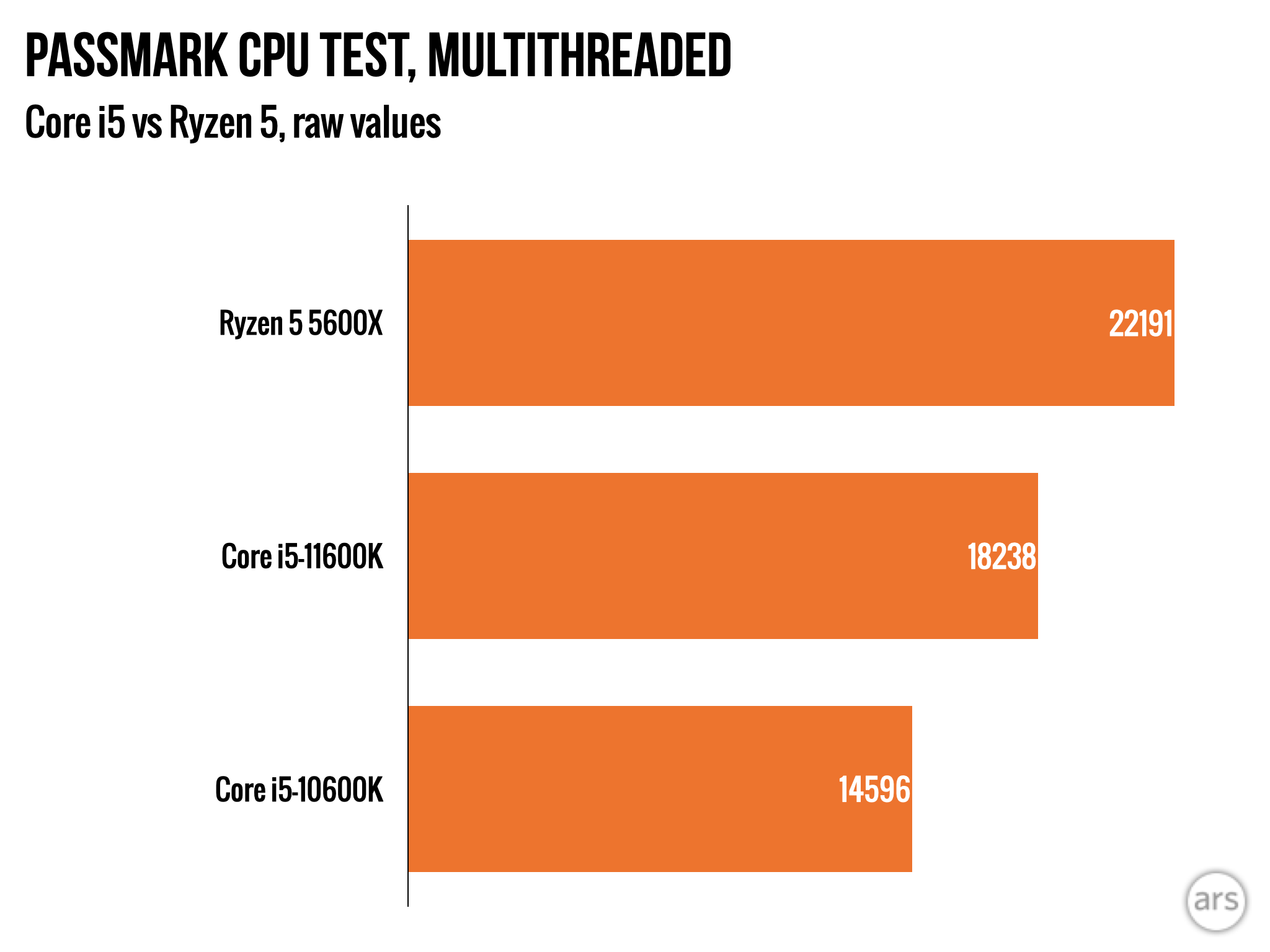 Unlike its Core i9 big brother, this year's Core i5 muscles handily past last year's model in the not-very-demanding Passmark multithreaded test.Jim Salter
Unlike its Core i9 big brother, this year's Core i5 muscles handily past last year's model in the not-very-demanding Passmark multithreaded test.Jim Salter This year's i5 slightly outperforms last year's, on multithreaded Geekbench. Neither comes close to Ryzen 5 5600X.Jim Salter
This year's i5 slightly outperforms last year's, on multithreaded Geekbench. Neither comes close to Ryzen 5 5600X.Jim Salter
This year's Core i5 makes a much better showing than its Core i9 big sibling. In Cinebench R20, the i5-11600K almost catches up with Ryzen 5 5600X, and it easily dominates last year's Comet Lake i5 equivalent. It doesn't come very close to its Ryzen competitor in Passmark or Geekbench multithreaded tests, but it does outpace last year's model all the way around.
This represents the clearest, most significant generation-on-generation victory we saw out of Rocket Lake-S.
Single-threaded CPU performance
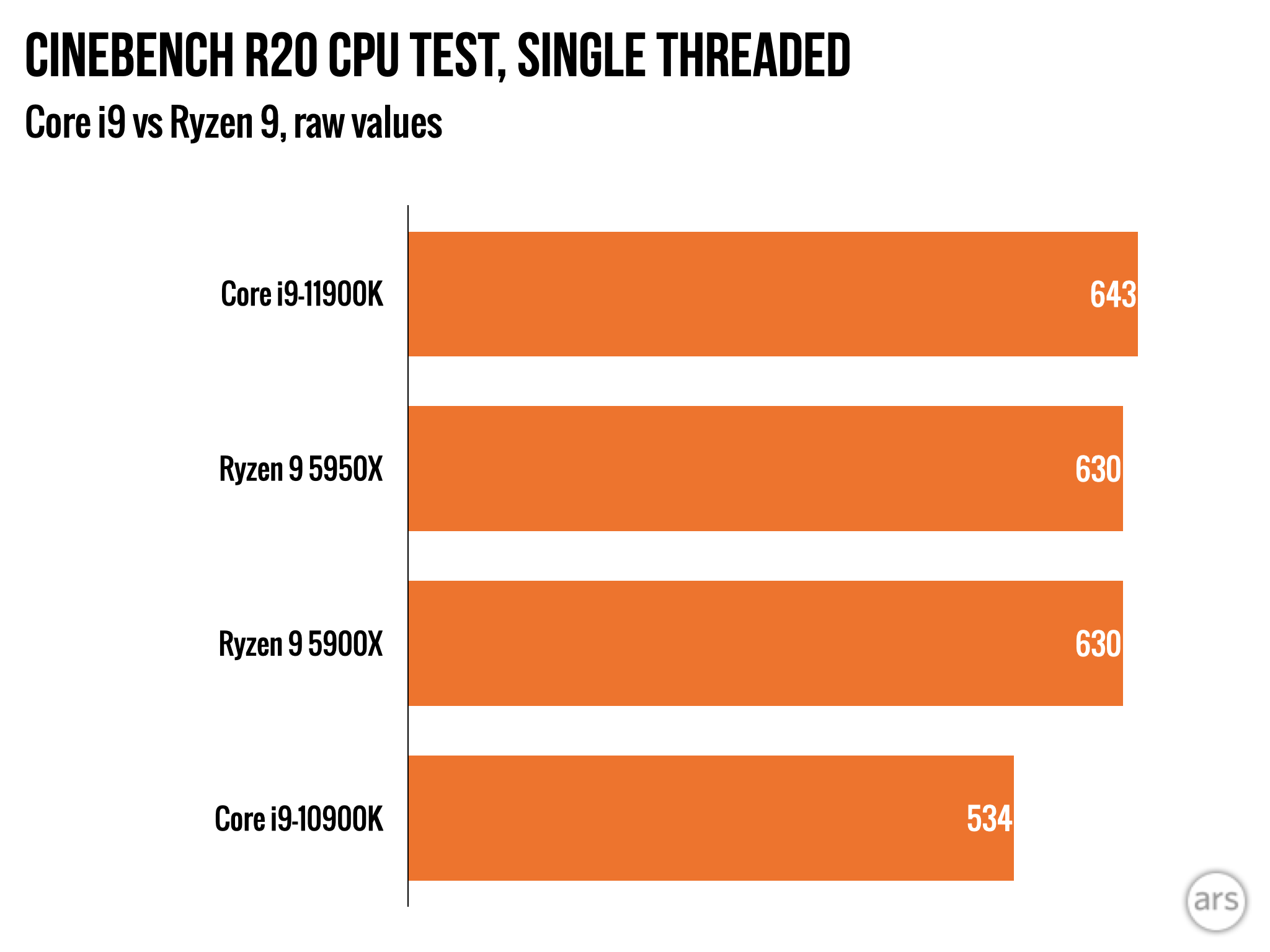 i9-11900K sets a new record for single-threaded Cinebench R20 performance—if by a razor-thin margin.Jim Salter
i9-11900K sets a new record for single-threaded Cinebench R20 performance—if by a razor-thin margin.Jim Salter i9-11900K edges just past its Ryzen 9 competition in single-threaded Passmark.Jim Salter
i9-11900K edges just past its Ryzen 9 competition in single-threaded Passmark.Jim Salter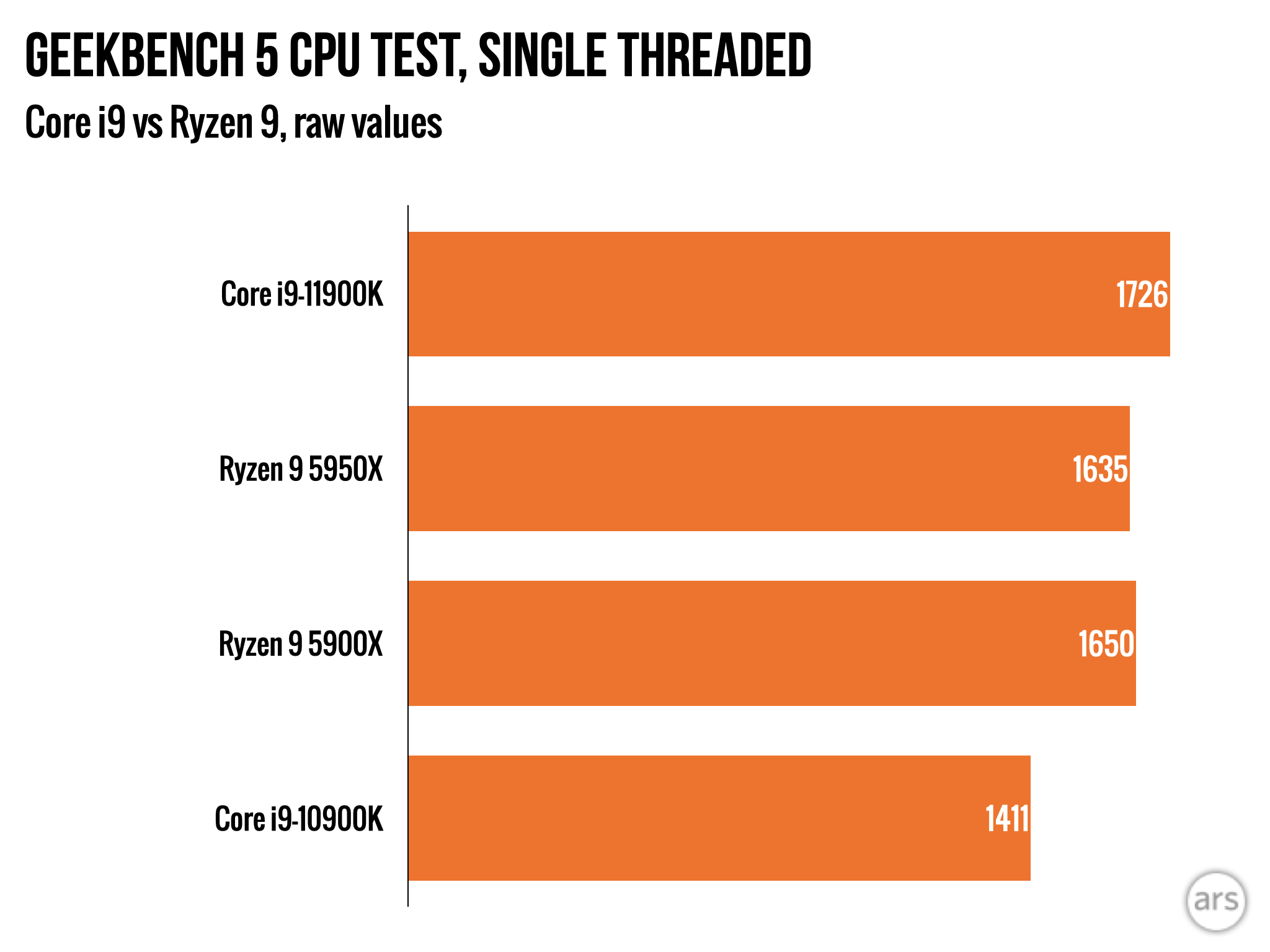 i9-11900K sets a new record for single-threaded Geekbench, edging past Ryzen 9 5900X.Jim Salter
i9-11900K sets a new record for single-threaded Geekbench, edging past Ryzen 9 5900X.Jim Salter
Core i9-11900K manages to set new records for single-threaded performance—if by razor-thin margins, when compared to Ryzen 9. Compared to last year's Comet Lake i9, those margins are much less thin.
As always, we advise readers not to make too much hay of this. Few real-world workloads are genuinely single-threaded, and even the largest margins shown here are quite thin.
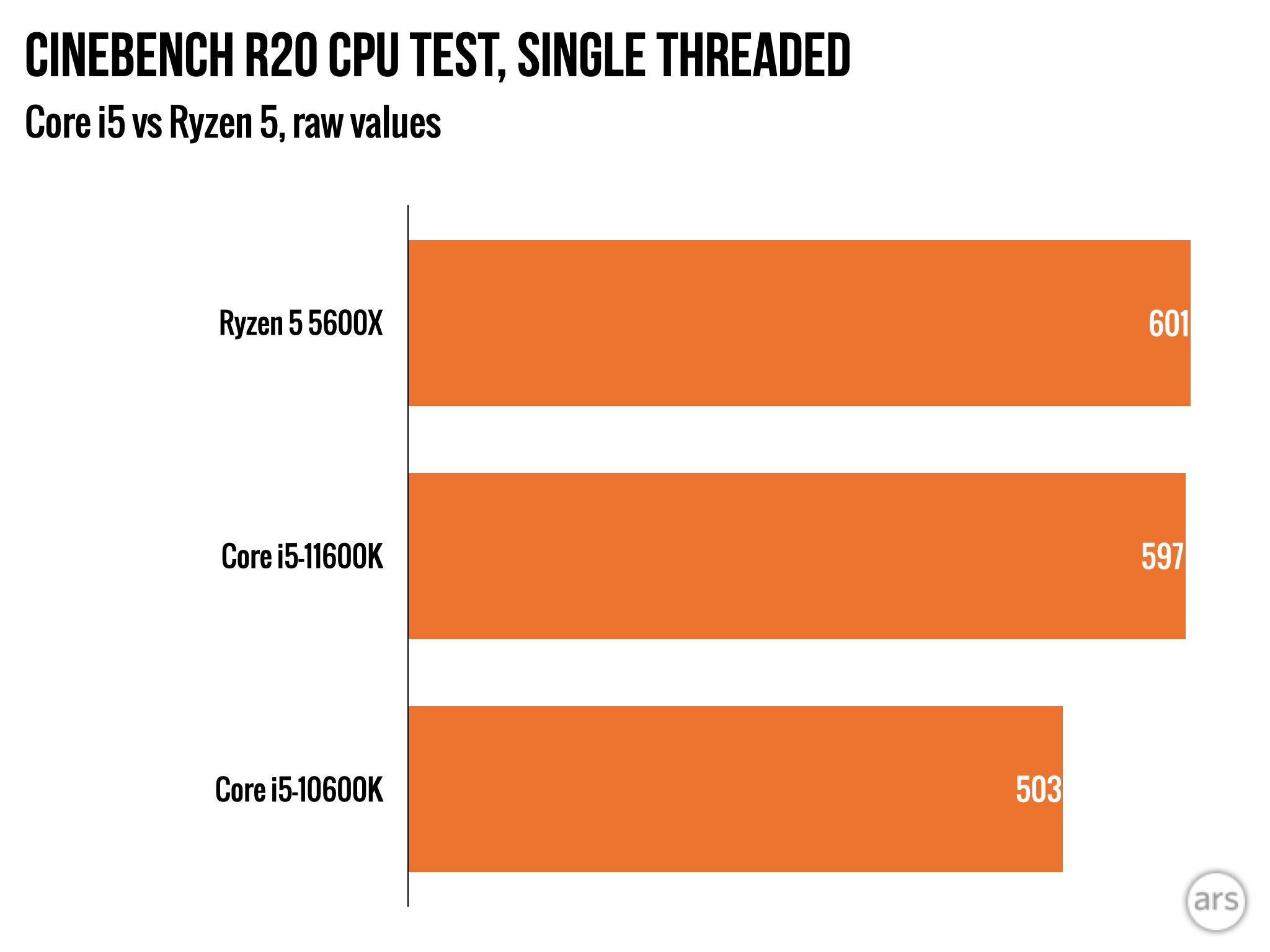 Our i5-11600K didn't quite catch up to its Ryzen 5 counterpart, but it easily won over last year's i5-10600K.Jim Salter
Our i5-11600K didn't quite catch up to its Ryzen 5 counterpart, but it easily won over last year's i5-10600K.Jim Salter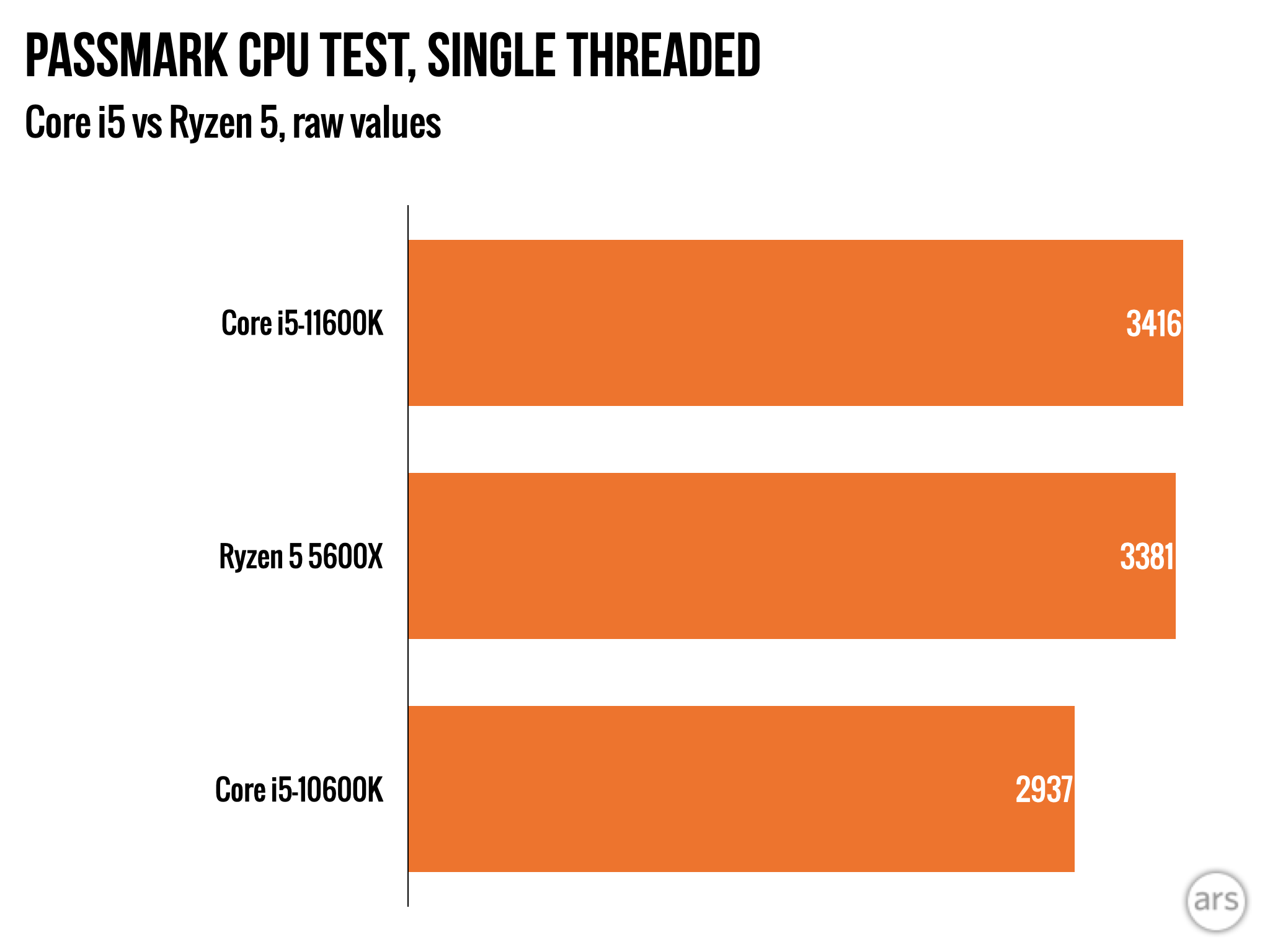 i5-11600K edges slightly past Ryzen 5 5600X in single-threaded Passmark.Jim Salter
i5-11600K edges slightly past Ryzen 5 5600X in single-threaded Passmark.Jim Salter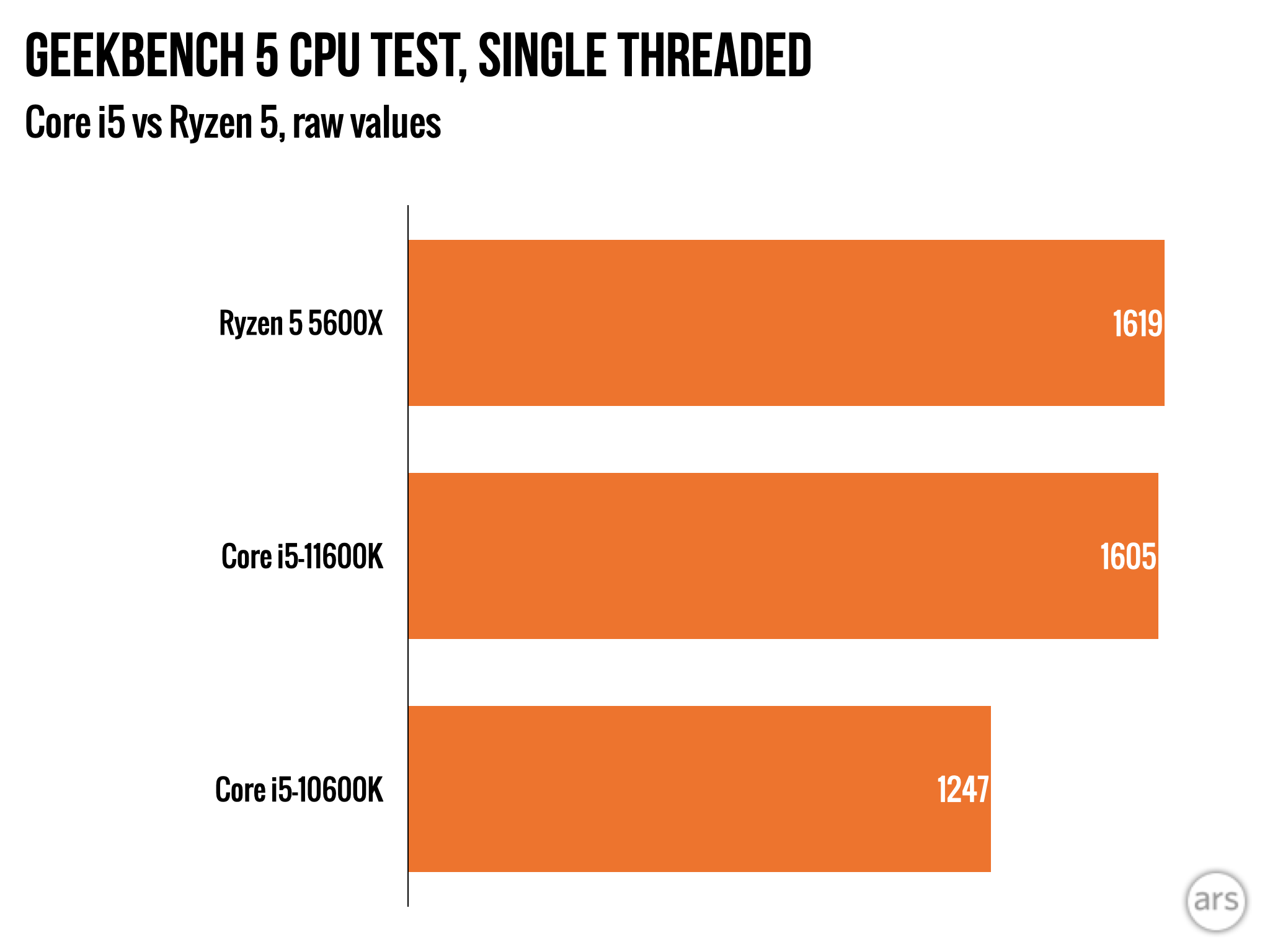 i5-11600K doesn't quite catch up to Ryzen 5 5600X, but it handily outpaces last year's i5 model.Jim Salter
i5-11600K doesn't quite catch up to Ryzen 5 5600X, but it handily outpaces last year's i5 model.Jim Salter
Core i5-11600K gets within a hair's breadth of Ryzen 5 5600X on single-threaded benchmarks, and it does so while scoring somewhat more significant victories over last year's Core i5-10600K. For the most part, this is the same relationship we saw between Rocket Lake-S, Zen 3, and Comet Lake in the previous Core i9 versus Ryzen 9 slides.
Gaming performance
 Despite flattening massively multithreaded advantages, Time Spy CPU was not kind to the i9-11900K, placing it a whopping 26 percent underneath last year's 10900K.Jim Salter
Despite flattening massively multithreaded advantages, Time Spy CPU was not kind to the i9-11900K, placing it a whopping 26 percent underneath last year's 10900K.Jim Salter The Time Spy CPU test disapproves strongly of our Rocket Lake-S CPU sample. Despite identical core+thread count, our i5-11600K gets dominated by last year's i5-10600K.Jim Salter
The Time Spy CPU test disapproves strongly of our Rocket Lake-S CPU sample. Despite identical core+thread count, our i5-11600K gets dominated by last year's i5-10600K.Jim Salter Time Spy Extreme—which allows for higher core-count usage and more advanced CPU optimized math libraries—disapproved strongly of our i9-11900K.Jim Salter
Time Spy Extreme—which allows for higher core-count usage and more advanced CPU optimized math libraries—disapproved strongly of our i9-11900K.Jim Salter
Before you get too alarmed, this is the Time Spy CPU test only—it focuses on modeling physics in ways that don't lend themselves to GPU rendering. Assuming that typical games would see similar decreases in overall frame rate would be a grave error. Time Spy Extreme—which allows more advanced processor optimizations and higher thread count—exposes an even wider gap. (We only tested Time Spy Extreme on the Core i9.)
As we noted in the gaming-focused Spring 2021 System Guide, the CPU has minimal impact on AAA gaming—frame rate in most games is determined almost entirely by GPU. If the only thing you have open on your PC is the game, you only need to meet a minimum CPU threshold—roughly speaking, "2015-era i5 or better." However, the more extra tasks you load onto your system—browser tabs and email clients open in the background or, worst of all, stream-capturing your own games—the more CPU horsepower you'll need to keep things moving.
We saw effectively no change in overall Time Spy score between 10th- and 11th-generation CPUs—and we didn't expect to. Yes, the single-threaded performance increased significantly; no, that doesn't generally have a large impact on gaming performance.
Integrated GPU performance
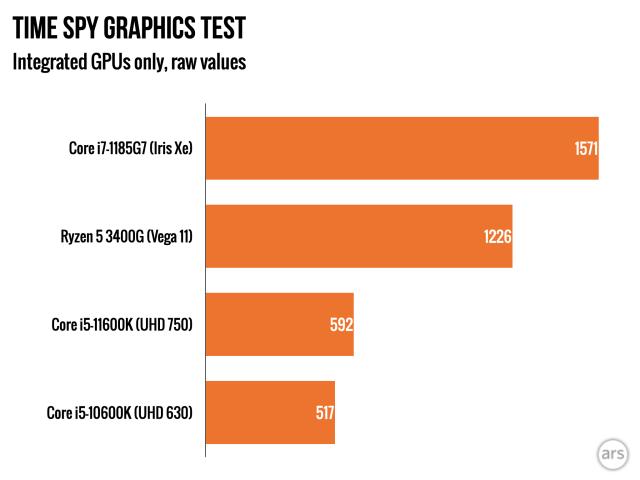
Rocket Lake-S gets a small but noticeable upgrade to its integrated graphics performance—the 10th-generation Core CPU's UHD 630 graphics gets bumped up to UHD 750. While it is an improvement, it's nothing to write home about—if you were hoping for an equivalent to Intel's Iris Xe graphics in Tiger Lake laptop CPUs (or AMD's Vega 11 in desktop APUs) you'll be sorely disappointed.
A modest GeForce GTX 1060 is good for a Time Spy Graphics score of roughly 4,000. Intel's flagship i7-1185G7 laptop CPU manages nearly half that at 1572, with AMD's Vega 11 lagging noticeably behind at 1226. Rocket Lake-S' UHD 750 comes in at a yawn-inducing 592—a little less than half the performance of Vega 11 and a little more than one-third the performance of Iris Xe.
Although the UHD graphics are sorely underwhelming, we should point out that they do at least exist. Competing Ryzen CPUs in the retail channel offer no integrated graphics at all—and with the current supply shortages and ugly price hikes in discrete GPUs, that can mean paying a nasty premium in full-system builds that aren't supposed to focus on gaming in the first place.
Power efficiency
 Power efficiency is the best thing about this year's Rocket Lake-S as compared to last year's Comet Lake.Jim Salter
Power efficiency is the best thing about this year's Rocket Lake-S as compared to last year's Comet Lake.Jim Salter i9-11900K is slightly more efficient in terms of performance per watt than i9-10900K was. But it's still less than half as efficient as Ryzen 9 5950X.Jim Salter
i9-11900K is slightly more efficient in terms of performance per watt than i9-10900K was. But it's still less than half as efficient as Ryzen 9 5950X.Jim Salter
The single biggest gain we saw from 11th-generation Core CPUs over 10th-generation is in power efficiency. Under their highest load—as seen in multithreaded Cinebench R20 tests—the i9-11900K cuts the whole-system power budget by a whopping 58 W.
This advantage is undercut somewhat by its correspondingly lower performance—but the newer-generation i9 still turns in a nearly 9 percent performance-per-watt improvement. Ryzen 9, of course, is the elephant in the room—with both lower power draw and higher performance, Ryzen 9 5900X and Ryzen 9 5950X both turn in more than double the performance-per-watt of Core i9-11900K.
Core i5-11600K (not pictured above) turns in roughly the same desktop idle and performance per watt, at 67 W and 22.0, respectively. Its maximum observed power draw was 194 W—much lower than Core i9-11900K's whole-system power draw but within shouting distance of the power draw coming from the massively more powerful Ryzen 9 CPUs.
As long as we're talking about power consumption, we'll point out again that the stated processor TDP is a fiction—both Core i9-11900K and Core i5-11600K are "95 W TDP" parts according to Intel's Ark. But the difference in power consumption between desktop idle and flat-out multithreaded processing is 125 W for the Core i5, and a whopping 208 W for the Core i9.
If all you budget for CPU cooling is "95 W," you'll be incredibly disappointed with either of these CPUs.
A note on clock speed
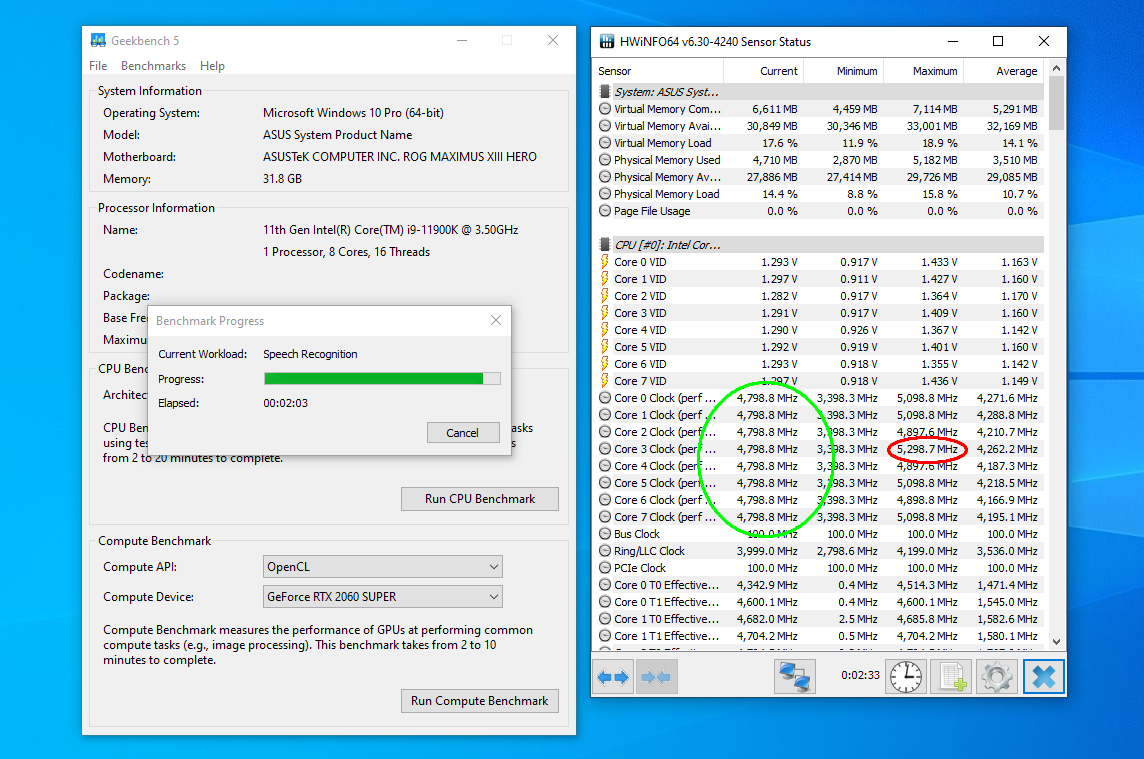 Jim Salter
Jim Salter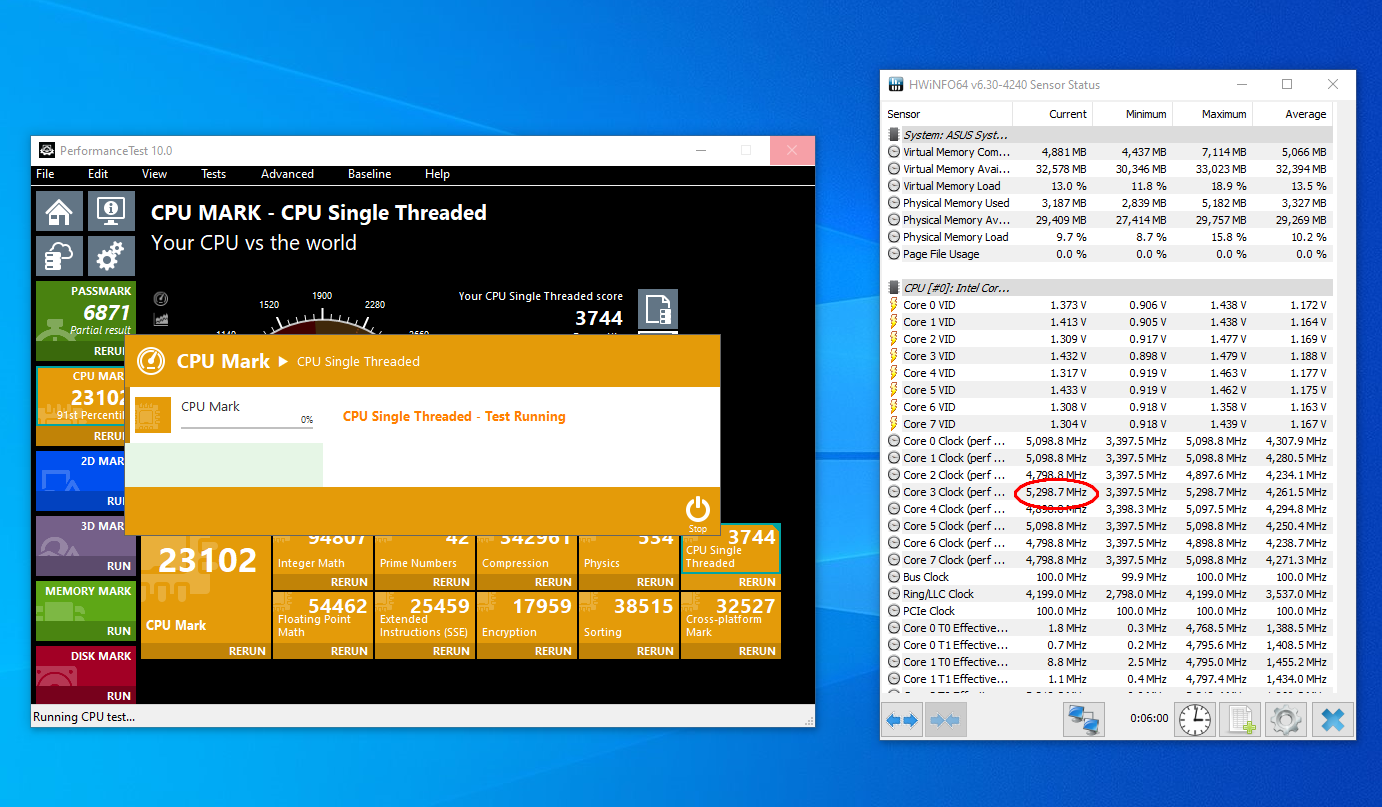 Jim Salter
Jim Salter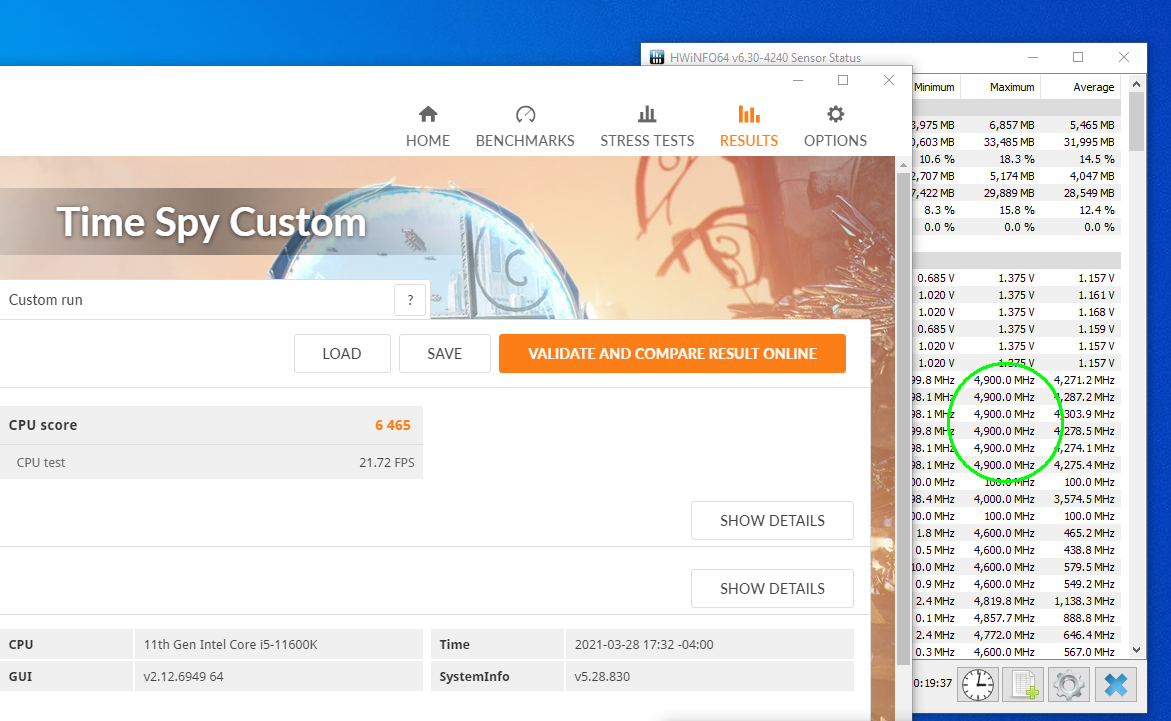 Jim Salter
Jim Salter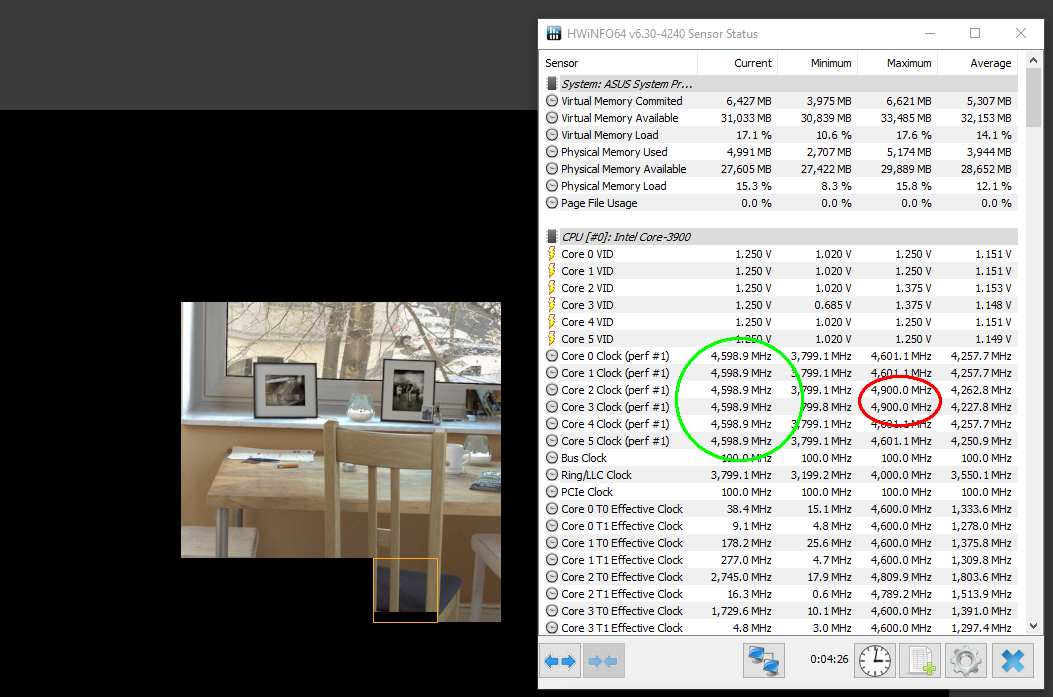 Jim Salter
Jim Salter
We don't recommend that readers obsess about clock speed, despite how frequently marketing materials emphasize it. A difference of 100 MHz here or there does not generally equate to a visible difference in performance—and in some cases, the IPC at extremely high speeds may drop, leading to an experienced performance decrease.
With that said, given the relatively low performance levels we observed in both Core i9-11900K and Core i5-10600K, we made sure to keep an eye on observed clock speeds.
Core i9-11900K hit its expected 4.8 GHz all-core turbo exactly as it should, with corresponding expected Thermal Velocity Boost frequency of 5.3 GHz on single-threaded workloads. Not all cores appeared to be capable of that 5.3 GHz maximum frequency—despite many single-core speedruns using various test suites, cores 2, 4, and 6 never exceeded 4.9 GHz, and cores 0, 1, 5, and 7 never broke 5.1 GHz.
Most single-threaded workloads on our Core i9-11900K shifted quickly to Core 3, which is the only core we ever observed reaching 5.3 GHz.
Core i5-11600K hit its own expected 4.9 GHz all-core turbo—but during single-threaded tests, we only saw speeds of 4.6 GHz.
Conclusions
Assuming we didn't get a defective pair of CPUs—or a defective motherboard—this was a disappointing release cycle for Intel's desktop gaming lineup. It appears as though Intel exerted a maximum effort to reach single-threaded parity with AMD's Ryzen 9 and Ryzen 5, at the price of a significant decrease in multithreaded performance.
This is not a win for consumers—although gamers tend to obsess over single-threaded performance, game frame rates are typically far more dependent on GPU than CPU. Even workloads that can't benefit from the entire thread count of the biggest Ryzen processors generally track lightly multithreaded performance more closely than true single-threaded performance. When adding in background tasks—email clients, browser windows, or even game-stream capture—the multithreaded performance advantage becomes even more important.
The biggest improvements we saw from the 11th-generation Rocket Lake-S came in power consumption and efficiency—these are still far more power-hungry CPUs than their Ryzen counterparts, but they've at least closed the gap significantly since the 10th generation. Integrated graphics are also slightly better—though still pitiful compared to those found in high-end laptop iGPUs like Intel's own i7-1185G7.
Intel's strategy of backporting features from its 10 nm process to Rocket Lake-S' 14 nm process does not seem to us to have panned out. At this point, Chipzilla seems doomed to lag behind AMD unless and until it can finally get its process node shrink back on track.
The Good
- Lower power consumption than 10th-gen Intel desktop CPUs
- Slightly higher power efficiency than 10th-gen Intel desktop CPUs
- Slightly improved integrated graphics compared to 10th-gen Intel desktop CPUs
- Actual presence of integrated graphics—competing Ryzen CPUs have none at all
- Higher single-threaded performance than 10th-gen, equivalent to competing Ryzen 5000 series CPUs
The Bad
- Lower multithreaded performance than 10th-gen
- Massively lower multithreaded performance than Ryzen
- Massively higher power consumption than Ryzen
The Ugly
- Rocket Lake-S seems more like gen-on-gen backsliding than improvement
- AMD processors still offer much higher performance and lower power draw, for roughly the same price
https://ift.tt/31y801y
Technology
Bagikan Berita Ini














0 Response to "Intel 11th-generation Rocket Lake-S gaming CPUs did not impress us - Ars Technica"
Post a Comment